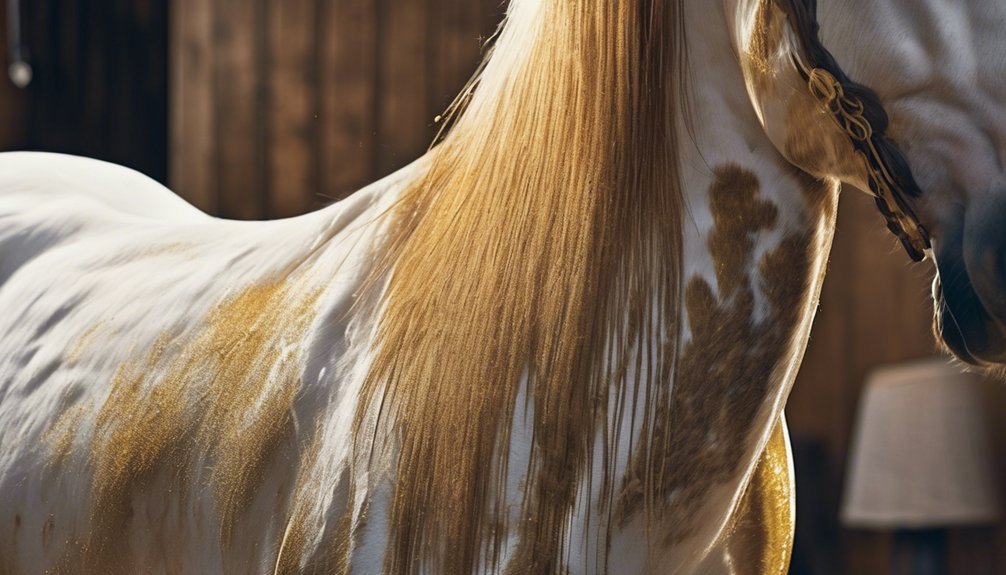
Grooming horses with thick coats can be a rewarding yet challenging task. It requires the right tools and techniques to ensure your horse's comfort and health. You'll need to understand how to effectively manage their dense fur, especially during shedding seasons. By mastering the proper brushing methods and incorporating essential care routines, you can maintain your horse's coat in top condition. Let's explore what it takes to keep your horse looking its best.
Key Takeaways
- Use stiff-bristled brushes to effectively loosen dirt and debris from thick coats before transitioning to softer brushes for a polished finish.
- Employ curry combs in long, sweeping strokes to cover large areas while ensuring comfort for the horse.
- Regularly groom during shedding seasons with shedding blades and rubber curry combs to manage excess hair.
- Bathe your horse in lukewarm water, using mild shampoo and ensuring thorough rinsing for optimal coat health.
- Maintain a balanced diet rich in vitamins and minerals to support skin health and enhance coat quality.
Understanding the Thick Coat

A horse's thick coat serves as its natural armor, providing insulation and protection from the elements. Understanding coat types is essential, especially as seasonal changes impact your horse's grooming needs.
In winter, the coat becomes dense and fluffy, trapping warmth. As spring approaches, this thick layer sheds, revealing a sleeker coat underneath. You'll notice your horse may require more frequent grooming during this time to manage loose hair effectively.
Pay attention to texture—some horses have coarse, wiry coats while others sport a softer, silkier feel. Each type needs a tailored approach to grooming.
You'll build trust and intimacy with your horse as you maintain their coat, ensuring they feel comfortable and cared for throughout seasonal transitions.
Essential Grooming Tools
Maintaining your horse's coat requires the right tools to ensure effective grooming.
Start with high-quality grooming brushes; a stiff-bristled brush works wonders for loosening dirt and debris from thick coats. Follow up with a soft brush to remove finer particles and give your horse that shiny finish.
Don't forget shedding tools, especially during seasonal changes. A shedding blade or rubber curry comb can help efficiently remove excess hair.
These tools not only keep your horse looking great but also contribute to their skin health by promoting circulation.
Investing in these essential grooming tools will make your grooming routine smoother and more enjoyable for both you and your horse, creating a deeper bond through this shared experience.
Brushing Techniques for Thick Coats

When it comes to grooming horses with thick coats, using the right brushing techniques can make all the difference. Start with a curry comb to loosen dirt and hair, then follow up with softer brushes for a smooth finish.
Employ these key strategies:
- Maneuvering brushes: Use long, sweeping strokes to effectively cover large areas without causing discomfort.
- Detangling techniques: For knots, gently work from the ends towards the roots, using your fingers or a detangling brush for stubborn areas.
- Layering approach: Begin with coarser brushes and gradually switch to finer ones, ensuring you remove all debris and reduce irritation.
These techniques not only keep your horse looking great but also strengthen your bond through gentle care.
Bathing Your Horse Effectively
Bathing your horse can be a refreshing experience for both you and your equine companion, especially after a long day of riding or a muddy romp in the pasture.
Start by choosing a calm day, ideally when it's not too hot or cold. Set the right water temperature—lukewarm is usually best—to ensure comfort.
Use a gentle hose or bucket to wet your horse thoroughly, beginning at the neck and working downward. Apply a mild equine shampoo, lathering well but avoiding sensitive areas like the eyes.
Rinse thoroughly, ensuring no soap residue remains. Finally, dry your horse with a clean towel or allow them to shake off excess water.
This bond during bath time not only cleans but strengthens your connection.
Managing Shedding Seasons

As the seasons change, your horse will naturally shed its coat, and managing this process can make a significant difference in their comfort and appearance.
You'll notice increased shedding frequency during spring and fall, so here are some practical tips to help you through these seasonal changes:
- Brush regularly: Use a shedding blade or curry comb to help loosen and remove excess hair.
- Monitor diet: Ensure your horse gets a balanced diet rich in vitamins and minerals to support healthy skin and coat.
- Create a calm environment: Reduce stressors to keep your horse comfortable, as anxiety can affect shedding.
Checking for Skin Issues
After managing shedding seasons, it's important to keep an eye out for skin issues that can arise during this time.
Regular skin inspection is vital, as you'll want to identify any signs of irritation or infection early. Look for common ailments like rain rot, scratches, or ringworm, which can thrive in thick coats.
Run your hands over your horse's body, feeling for unusual lumps, bumps, or heat under the skin. Check areas that are prone to moisture, like the belly and under the mane.
Don't forget to examine the legs and face, as these spots can reveal hidden problems. If you notice anything concerning, consult your veterinarian for advice on treatment options.
Your horse's health depends on your vigilance!
Importance of Regular Hoof Care

Regular hoof care is essential for maintaining your horse's overall health and performance. Neglecting hoof health can lead to painful conditions and decreased mobility.
By incorporating effective trimming techniques and routine checks, you ensure your horse stays comfortable and active.
Here are some key benefits of regular hoof care:
- Prevention of Lameness: Consistent trimming keeps hooves balanced, reducing the risk of lameness.
- Early Detection of Issues: Regular inspections help you spot problems like thrush or cracks before they escalate.
- Enhanced Performance: Healthy hooves support your horse's athletic abilities, ensuring they can perform at their best.
Investing in hoof care not only benefits your horse but deepens the bond between you, as you learn to read their needs and respond with care.
Incorporating Nutritional Support
While grooming your horse, don't overlook the crucial role of nutritional support in their overall well-being. A well-balanced diet is essential for maintaining coat health, especially for horses with thick coats that can trap dirt and moisture.
Incorporating nutritional supplements rich in omega-3 fatty acids, biotin, and essential vitamins can significantly enhance the luster and texture of your horse's coat. These supplements not only promote a shiny appearance but also improve skin health, reducing the likelihood of irritations.
Don't forget to consult with your veterinarian or an equine nutritionist to tailor a supplement plan that meets your horse's specific needs. By addressing nutritional support, you're investing in your horse's beauty and health, ensuring they feel as good as they look.
Grooming for Show Preparation

To ensure your horse looks its best for show day, start grooming well in advance of the event.
Focus on the coat presentation, as a sleek, shiny coat can make all the difference in the show ring.
Here are a few tips to help you prepare:
- Brush thoroughly: Use a variety of brushes to remove dirt and debris, promoting a healthy coat.
- Keep it clean: Bathe your horse a few days before the show to allow the coat to settle and shine.
- Use coat enhancers: Consider using products specifically designed to enhance coat luster and condition.
With consistent grooming, your horse will stand out in the show ring, showcasing the hard work and love you've put into their care.
Building a Grooming Routine
Establishing a grooming routine is essential for maintaining your horse's health and appearance. Start by determining a grooming frequency that works for both you and your horse, ideally every other day or daily during shedding seasons.
Pay attention to your horse's coat and adjust your routine seasonally; during colder months, you might need to focus more on removing dirt and debris, while in warmer months, a thorough brushing will help distribute natural oils.
Incorporate tools like curry combs, dandy brushes, and soft brushes to effectively manage thick coats. Don't forget to check hooves and skin for any issues.
Consistency in your grooming routine not only keeps your horse looking great but also strengthens your bond.
Frequently Asked Questions
How Often Should I Groom a Horse With a Thick Coat?
You should groom your horse daily for optimal coat maintenance. Regular grooming frequency helps remove dirt and loose hair, promoting a healthy coat while strengthening your bond. Make it a cherished routine you both enjoy.
Can I Use Human Grooming Tools on My Horse?
You can use some human grooming tools on your horse, but ensure they're safe and suitable. Human tools often lack the durability and design needed for equine grooming, so choose wisely to prevent any injuries.
What Are Signs of Poor Grooming in Horses?
If you're noticing a dull coat or excessive dirt buildup, it's likely a sign of poor grooming. Regular grooming frequency is crucial for maintaining coat health, so don't skip those important bonding moments with your horse.
Should I Groom My Horse Before or After Exercise?
Imagine your horse, muscles glistening, ready for action. Grooming before exercise enhances circulation and promotes bonding, while post-exercise grooming eliminates sweat and dirt. Integrating grooming into your routine maximizes both health and connection with your equine partner.
How Can I Prevent My Horse From Getting Knots in Their Coat?
To prevent knots in your horse's coat, use effective grooming techniques like regular brushing and detangling tools. Incorporate preventive measures such as keeping their coat clean and well-maintained, fostering a strong bond with your equine friend.
Conclusion
In the dance of grooming, your horse's thick coat becomes a canvas for care and connection. With the right tools and techniques, you can transform grooming into a soothing ritual, shedding not just loose hair but also worries. Embrace the changing seasons, and remember that each stroke builds trust between you and your equine companion. By nurturing their coat and hooves, you're not just enhancing their appearance; you're also strengthening your bond, creating a partnership that shines bright.





